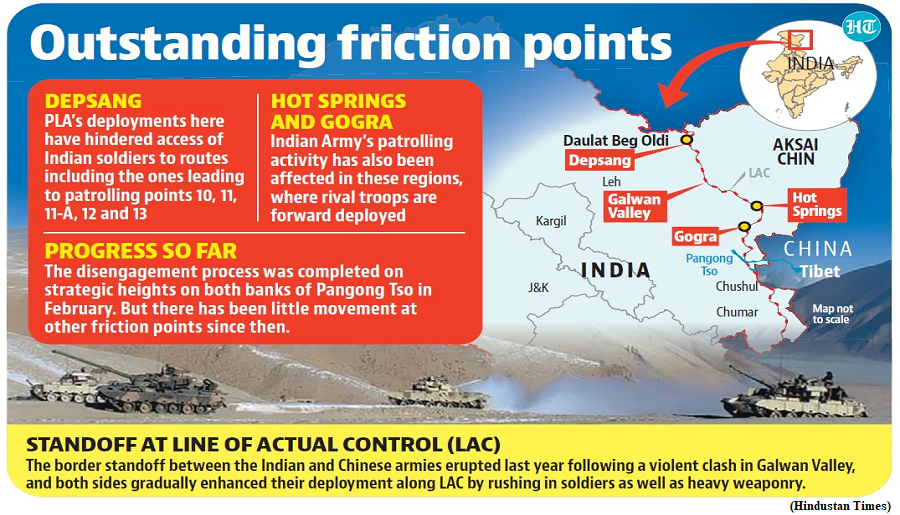What are the friction points on the LAC? (GS Paper 2, International Relation)

Why in news?
- As the 2020 standoff in Eastern Ladakh marks three years, India and China are far from achieving the objective of disengagement and de-escalation and restoration of status quo ante to resolve the situation along the Line of Actual Control (LAC).
- As part of the disengagement process from the friction points in Eastern Ladakh, India and China have been engaged in talks at the diplomatic, military and political level, with the senior military commander-level talks being the major avenue to undertake disengagement and de-escalation and resolve the standoff that began in May 2020.
Where is the disengagement process?
- Since the Corps commander level talks in 2020, the two sides have so far undertaken disengagement from five friction points;
- at Galwan after the violent clash in June 2020,
- the north and south banks of Pangong Tso in February 2021,
- at Patrolling Point (PP) 17 in the Gogra-Hot Springs area in August 2021, and
- PP15 in September 2022.
- On the Depsang Plains and Demchok, there are fundamental disagreements, as India maintains that they are the two additional friction points that still remain while China has refused to accept it, terming them as legacy issues predating the 2020 standoff.
Concerns:
- On several occasions, Army Chief Gen Manoj Pande has termed the situation along the LAC as “stable but unpredictable” while stating that five out of the seven friction points in Eastern Ladakh have been resolved and the focus is now on the remaining two points.
- The 18th round of Corps Commander talks was held at the Chushul Moldo meeting point on the Chinese side in April 2023.
- On May 31, 2023, India and China held the 27th Meeting of the Working Mechanism for Consultation and Coordination on India-China Border affairs (WMCC) in New Delhi which made no headway and the two sides agreed to hold the 19th round of Corps Commanders talks very soon.
De-escalation:
- Meanwhile, China has been undertaking massive build-up of infrastructure, habitat and induction of new weapons and equipment along the 3,488 km-long LAC, fundamentally altering the status quo on the ground.
- India too has been building infrastructure and undertaking capability enhancement to match the Chinese.
- This is in addition to the over 50,000 troops and heavy equipment, on each side, that continue to be deployed close to the LAC in Eastern Ladakh. In this backdrop, any de-escalation to restore the status quo predating the standoff looks remote.
What are buffer zones?
- During the disengagement process, buffer zones were created at the friction points as per the understanding reached at the Corps Commanders-level talks.
- It was decided that both sides would pull back at an equal distance from the friction points to prevent any fresh flare-ups; also, no patrolling would be undertaken by both sides till the overall disengagement and de-escalation is achieved after which the two sides have to work out new patrolling norms to maintain peace and tranquillity.
- All disengagements carried out earlier have been done on the basis of mutual and equal security with no prejudice to LAC claims by either side.
What is their status?
- Since the beginning of the standoff, China had moved large number of troops and equipment close to the LAC in addition to the ingress by Chinese troops inside Indian territory at friction points. On the North Bank, Chinese troops made ingress from Finger 8 up to Finger 4 blocking Indian patrols.
- India holds its place till Finger 4 but claims territory till Finger 8 as per alignment of the LAC. Disengagement has been undertaken there since and buffer zones at all the five points continue to be in place, sources said.
- To ensure that the Chinese are fully honouring the understanding reached, verification by aerial monitoring using Unmanned Aerial Vehicles (UAV) as well as satellites is undertaken regularly.
- In fact, during the first phase of disengagement both sides had pulled back troops by equal distance from Patrolling Points (PP) 14 in Galwan valley and PP15 in Gogra-Hot Springs during which violent clashes had occurred resulting in the deaths of 20 Indian personnel and at least five deaths on the Chinese side.
What is the strategic significance of Depsang?
- Demchok is one of the two mutually agreed disputed areas in Eastern Ladakh, while Depsang is another friction point. In Demchok while there are varying claims in the Charding La area, China has set up tents on this side of Charding nala.
- The crucial Sub-Sector North (SSN) consists of the Depsang plains and Daulat Beg Oldie (DBO). Currently, the airfield at DBO is accessible by the 255 km-long Darbuk-Shyok-DBO (DSDBO) road. A plan for an alternate axis across Saser La which has an ancient trade route, is in the works.
- In Depsang Plains, Chinese troops have been blocking Indian Army patrols from going up to the PPs 10, 11, 11A, 12 and 13, beyond the Y junction. Chinese build-up in this area threatens Indian positions at DBO and also brings Chinese troops closer to the DSDBO road.
- Depsang is also close to the Karakoram pass overlooking the strategic Saltoro ridge and Siachen glacier, the world’s highest battlefield. The Indian Army last accessed the patrolling points in Depsang in January/February 2020.
- Also, the distance from the Limit of Patrol (LoP), on which the PPs are marked, to the LAC is the maximum in the Depsang area.
- Depsang has seen several face-offs in the past and as reported earlier, officials pointed out that as India’s capacity in the area increased, especially since 2013, the number of troops and frequency of patrols had gone up and with it the number of face-offs.


